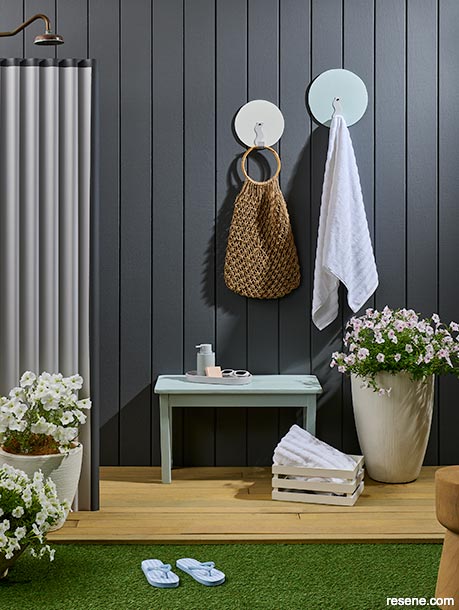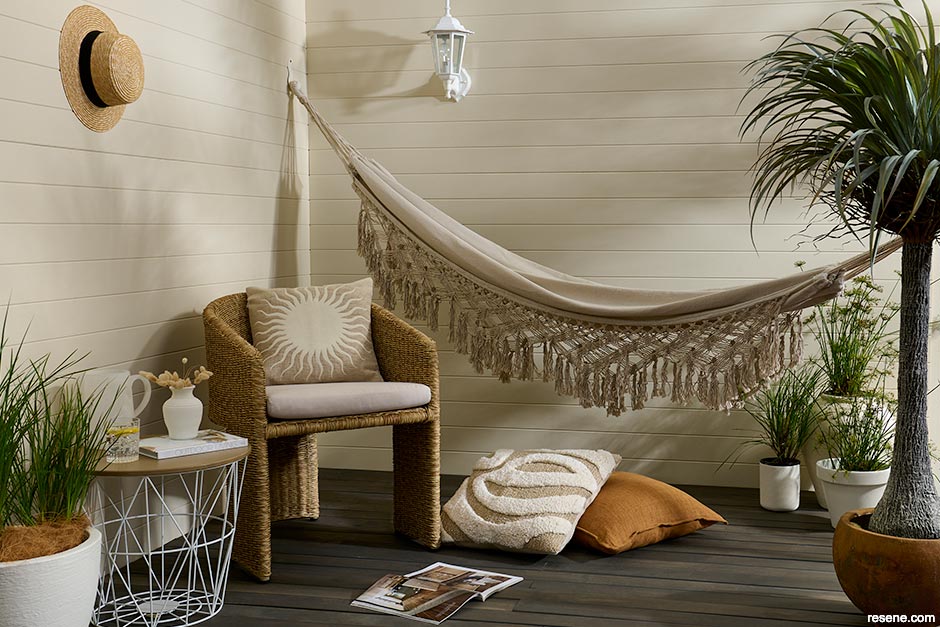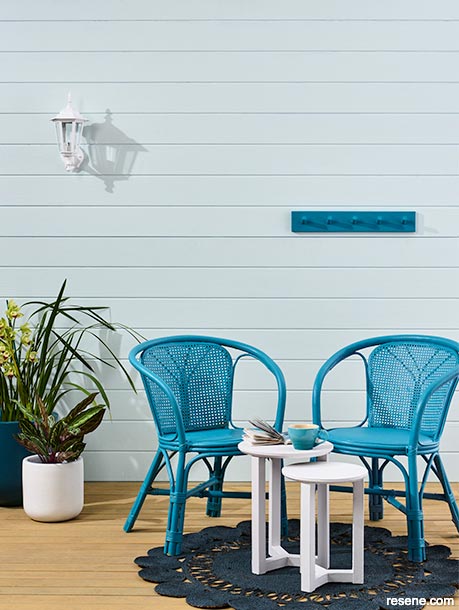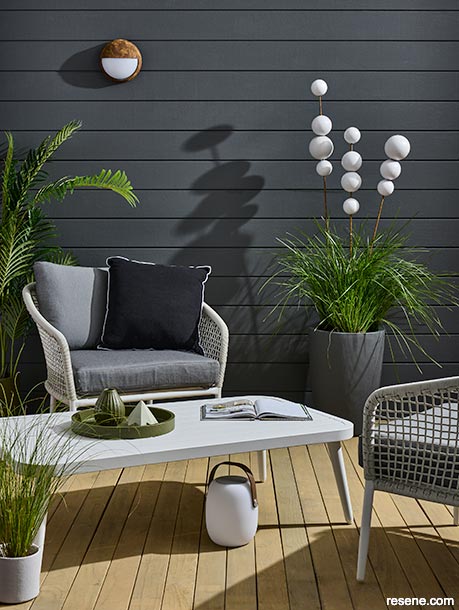From the Resene decorating blog
The painted exterior of any house can have a tough life, exposed to the elements and, in some cases, extreme temperature changes.

Checking the correct spreading rate of your paint helps ensure you apply enough product so your surface is adequately protected.
This wall is painted in Resene Half Baltic Sea, with decking stained in Resene Woodsman Uluru, shower screen in Resene Pale Slate, bench in Resene Nebula, planters and crate in Resene Villa White, stump stool in Resene Bask and hooks in Resene Nebula and Resene Villa White. Jandals from Number One Shoes, Resene Living soap dispenser from Briscoes. Project by Melle Van Sambeek, image by Bryce Carleton.
To help your paint finish last well and continue to look good for years to come, there are some simple things you can do, and precautions you can take to keep the surface protected.
Resene Paint Expert Jay Sharples says most common problems affecting the exterior paintwork on a house relate to the substrate (the surface you are painting, such as weatherboards) – and most of those relate to movement, particularly with timber.
“Timber expands and contracts throughout the year,” Jay says. “When timber gets wet it swells anywhere from 1% to 5%. That might not sound like much, but a 2% change over a board 20cm wide is a movement in paint film thickness of 4000 microns or 4mm. The average coat of paint is only 35 microns thick!”
To prevent too much water being absorbed into the wood, it’s important it’s sealed when cut, or, for timber joinery, sealed when constructed, he says.
“The end-grain of timber is the major problem because water is absorbed through that 50 times faster than through the face of the timber.
“That also means that when you check to see if areas of your house need painting, any visible or bare areas of timber, any cracks or splits in the timber or around fixings, will need attention sooner rather than later.”
At the end of a long, hot and dry summer, the timber will have shrunk, Jay says. “That’s when any bare or visible areas should be prepped, primed and painted before the winter comes and the timber swells again.”
Top tip: Check the recommended spreading rate on your paint pail to ensure you’re applying enough product so your surface is adequately protected. If the paint covers 10 square metres that means that you’ll have enough to cover two coats onto an area of wall 5 metres square (e.g. 2.5m x 2m). If you find you are using less paint, you’re applying it too thinly and the surface won’t be protected properly.
Too much heat can be damaging to both your painted surface and the substrate underneath it, particularly if it is timber. Too much heat can cause warping and cracking of timber as well as causing paint to bubble, crack or prematurely take on a dry, chalky look.

Darker paint colours are particularly prone to heat damage as they will naturally absorb more heat from harsh sunlight. “Take particular care when using dark colours on old previously painted timber and in extreme exposures,” Jay says as these are more prone to heat damage.
“New building materials will likely have LRV (Light Reflectance Value) restrictions so I’d recommend checking those before you paint.”
Jay also suggests working with a Resene CoolColour paint as this can help prevent heat-related issues. Resene CoolColour includes special pigment technology so it reflects more heat and won’t get as hot as a normal colour would, even in darker shades. Resene CoolColours are created by replacing the standard carbon black pigment that absorbs heat and light with a unique pigment that enables much of the infrared portion of the sun’s energy to be reflected.
If you have paint damage from the heat, clean the affected area and fill in cracks or gaps. Sand, wipe down and prime the area with Resene Quick Dry, before topcoating in your chosen Resene colour.
Resene Hot Weather Additive is another product that’ll help combat the effects of scorching temperatures on your finish – add it to your Resene waterborne paint to slow down the drying process and give a longer wet edge.
“It really helps with the flow of the paint for a great, professional finish," Jay says, adding that it’s best to avoid over-working or overspreading paint as it will dry faster and is more likely to lead to a streaky or patchy finish.
Top tip: Decant your topcoat into a roller tray or small Resene paint pot to avoid dust and dirt contaminating the main paint pail.
“Regular cleaning goes a long way to keeping your painted surface protected and looking great,” Jay says.

Preparation is key to giving your finished exterior a long life looking good. Always start by cleaning your surfaces and properly treating any mould or moss so it doesn’t recur.
Walls painted in Resene Carefree with decking stained in Resene Woodsman Uluru, chairs and hooks in Resene Calypso, sisal rug and large planter painted in Resene Coast and lamp, small planter and tables in Resene Alabaster. Mug from Le Creuset. Project by Megan Harrison-Turner, image by Bryce Carleton.

Use Resene CoolColour when painting exterior surfaces in dark shades to help reduce heat absorption.
Weatherboards and large planter painted in Resene Nocturnal, with deck stained in Resene Woodsman Uluru, small planter in Resene Coriander, tray in Resene Waiouru, sculpture rods and wall light in Resene FX Faux Rust Effect and bubble sculpture in Resene Alabaster. Chairs and table from Danske Møbler, speaker from Good Thing. Project by Melle Van Sambeek, image by Bryce Carleton.
“Resene has a slow-acting very easy-to-use cleaner called Resene Deep Clean. You attach to your hose and spray on to the surface area. My plan before the end of each summer is to clean down and/or water blast my deck, patio and pathways.
“I then spray with Resene Deep Clean to help keep the moss, mould, algae and lichen at bay over winter.”
For more keeping on top of ongoing exterior paint maintenance faster acting products like Resene Paint Prep & Housewash, Resene Bio-Cleaner, and Resene Heavy Duty Oil and Paint Cleaner are also very effective.
The other advantage of regularly cleaning of your painted surfaces, Jay says, is that it also gives you a chance to note any obvious signs of damage or breakdown and make a plan to fix it to avoid further damage. “A light sand, spot prime and touch up is much easier than having to strip large areas, fix rot or replace timber and fully repaint.”
Jay suggests cleaning your exterior painted and stained surfaces at least once a year as the bare minimum – and at least twice a year if your house is within 300m of salt water.
“Most people will clean their car, bike, boat at least once a month but often forget to clean their biggest asset – their house!”
Top tip: Don’t neglect your roof. Wash it at least once a year and treat any areas of lichen with Resene Moss & Mould Killer.
The most effective way to avoid common exterior paint problems is to ensure you prepare your surface properly before painting. Any powdery surface or loose paint underneath your new topcoat can cause problems as the substrate moves with temperature changes.
Is there any moss or mould present? A quick wash with water will not remove spores or small particles. A product like Resene Moss & Mould Killer is required to prevent moulds from regrowing underneath new paint.
Is the surface chalky or dirty? Wash and thoroughly rinse. Cleaning solutions ensure dirt is washed away from the surface, rather than just moved around.
Are there old sealants and putty? Remove any old products and replace with new. Test any previously painted areas to see how new paint adheres.
Colours mentioned in this blog...
Products mentioned in this blog...
February 13, 2024
If you need help deciding which part of your home to tackle first, take photos and bring them into your local Resene ColorShop or use the Ask a Resene Paint Expert service online.
Book a colour consult | Ask a Colour Expert | Ask a Paint Expert
Resene's decorating blog
Paint your home beautiful! Discover the latest decorating trends, tips and colour news.
![]()
Previous «
Decorate sustainably
![]()
Blog home
View the latest trends, tips and news
![]()
» Next
Decorating tricks and tips that won’t trip you up